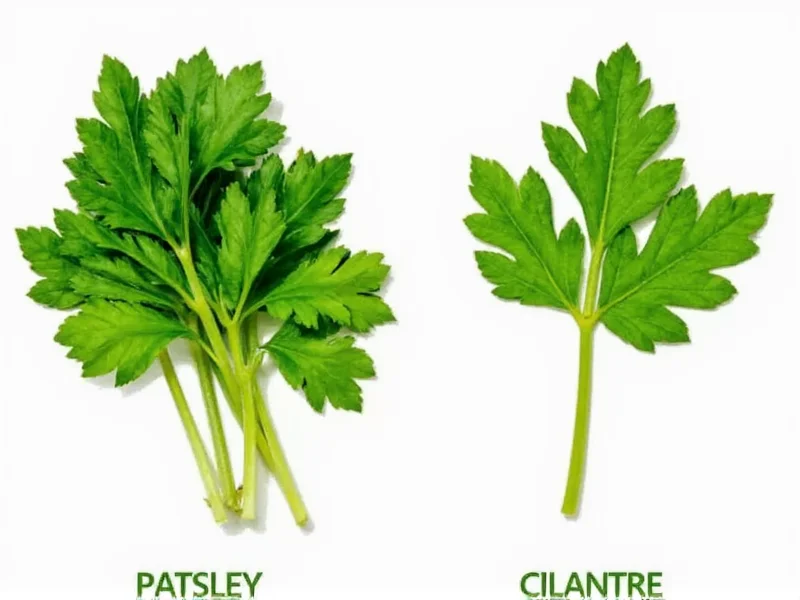Confusing parsley and cilantro is one of the most common herb mix-ups in kitchens worldwide. These two popular culinary herbs look remarkably similar at first glance, yet deliver dramatically different flavor profiles that can make or break your dish. Understanding how to tell the difference between parsley and cilantro isn't just helpful—it's essential for anyone who cooks regularly. Getting them mixed up could transform a refreshing salsa into a bland disappointment or turn a delicate herb sauce into an overpowering experience.
Visual Identification: Leaf Shape and Structure
The most reliable way to distinguish parsley from cilantro lies in examining the leaf structure. While both are bright green and grow in similar bunches, their leaf shapes follow distinct patterns that become obvious with close inspection.
| Characteristic | Parsley | Cilantro |
|---|---|---|
| Leaf Shape | Triangular with serrated edges, resembling flat ruffles | Rounded, almost circular with smooth edges |
| Leaf Texture | Thicker, more substantial feel | Thinner, more delicate texture |
| Color | Bright, almost yellowish green | Deeper, darker green |
| Stem Attachment | Leaves grow in clusters from central stem | Leaves appear to grow directly from stem |
When examining fresh bunches, look at the outer leaves first—they typically show the most pronounced differences. Flat-leaf parsley (also called Italian parsley) demonstrates these characteristics more clearly than curly parsley, which has more obviously ruffled leaves that make identification easier.
Sensory Differences: Aroma and Taste
When visual inspection isn't sufficient, your nose and taste buds become valuable identification tools. The aromatic compounds in these herbs create distinctly different sensory experiences:
- Parsley emits a mild, grassy scent with subtle earthy notes. When tasted raw, it delivers a clean, slightly peppery flavor that's refreshing without overwhelming other ingredients.
- Cilantro releases a strong citrus-pungent aroma with distinctive soapy notes (which some people genetically perceive as unpleasant soap flavor due to olfactory receptor variations).
For a definitive test, crush a single leaf between your fingers. Cilantro will immediately release its characteristic strong scent, while parsley produces a much milder fragrance. Remember that cooking dramatically changes cilantro's flavor profile—it becomes more muted and blends better with other ingredients, whereas parsley retains more of its fresh character.
Culinary Applications and Substitution Guidance
Understanding how to tell the difference between parsley and cilantro matters because they serve different culinary purposes:
Parsley functions as a versatile finishing herb that adds freshness without dominating. Chefs often use it in tabbouleh, gremolata, and as garnish for countless dishes. Its mild flavor makes it suitable for both cooked and raw applications.
Cilantro brings a bold, distinctive flavor essential to many global cuisines. It's indispensable in Mexican salsas, Thai curries, and Indian chutneys. Unlike parsley, cilantro's flavor diminishes significantly when cooked, so it's typically added at the end of preparation or used raw.
If you accidentally substitute one for the other, consider these adjustments:
- Using parsley instead of cilantro? Add a squeeze of lime and a pinch of cumin to approximate cilantro's citrusy notes.
- Using cilantro instead of parsley? Use half the amount and balance with additional mild herbs like chives.
Practical Identification Tips for Grocery Shopping
When selecting herbs at the store, follow these practical steps to ensure you're getting the right one:
- Examine the leaf tips: Parsley leaves come to a definite point, while cilantro leaves appear more rounded.
- Check the stem color: Parsley stems tend to be lighter green, sometimes with yellowish tones, while cilantro stems maintain a consistent deep green.
- Perform the crush test: Gently rub a leaf between your fingers—cilantro releases its strong scent immediately.
- Look at the bunch shape: Parsley grows in more upright, compact bunches, while cilantro tends to have a more sprawling growth pattern.
When in doubt, ask the produce manager for assistance—they often know the difference and can help you select the correct herb. Remember that dried versions won't help with identification, as both lose their distinctive characteristics when dehydrated.
Why Proper Identification Matters
Mistaking parsley for cilantro (or vice versa) can significantly alter your dish's outcome. Cilantro's strong flavor can overwhelm delicate recipes when parsley was intended, while using parsley in place of cilantro leaves Mexican and Asian dishes lacking their characteristic bright, citrusy notes.
For those with the genetic variation that makes cilantro taste like soap (estimated at 4-21% of the population depending on ethnicity), correctly identifying these herbs becomes even more crucial. If you're cooking for others, knowing how to tell the difference between parsley and cilantro ensures you won't accidentally serve an herb that might ruin the dining experience for some guests.











 浙公网安备
33010002000092号
浙公网安备
33010002000092号 浙B2-20120091-4
浙B2-20120091-4